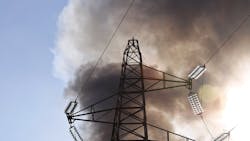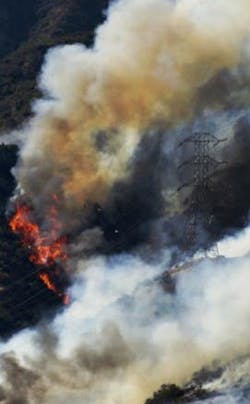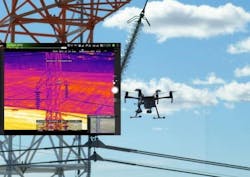Wildfire Risk Is Business Risk: How Utilities Can Mitigate It - Part One
What exactly are the responsibilities of the utility company?
Each year, the US is faced with a new wave of devastating wildfires. If not in California, then in Louisiana, or Hawaii, the responsibility for wildfire prevention and protection rests with a wide range of stakeholders. But utilities are near the top of the list. History has taught us hard lessons about how powerline infrastructure can spark or contribute to a blaze.
We know that downed powerlines have been ignition sources for previous fires when they come into contact with, for example, dry vegetation. That critical moment has two sides to the equation: the asset and the surrounding environment. Utilities have responsibilities in regard to both.
The good news is that there are powerful AI-enabled technologies that utilities can deploy to improve asset maintenance, vegetation management and reduce wildfire risk while also delivering commercial benefits simultaneously today.
Our recent work with California-based utility PG&E has seen it incorporate at-a-glance visual data technology across thousands of miles of its transmission lines in the High Fire-Threat Districts. Areas where the fire risk continues to increase year-on-year.
As part of its ongoing Wildfire Mitigation Plan, PG&E now has access to a wealth of information to inform planning and maintenance to proactively stay ahead of wildfires and the risk they present.
Step 1: Updating Maps
PG&E’s approach starts with a more accurate base of information. Those outdated and incomplete maps of assets must be brought up to date and made more useful. Ask any lineman on the job and they’ll tell you which circuits don’t just need the initial work, but rather, orienteering and investigating just to find out where to do the work. In 2023, that meant using sensor-equipped helicopters, trucks or fixed wing aircraft to perform data collection missions, which produce accurate and extensive 3D models of the scope of project, including its surroundings, such as vegetation and housing.
At a glance, just by having this accurate information, resources can be saved by no longer having crews deployed to the wrong location, or unprepared for the assets they will find on site.
Step 2: Digital Twin
But more can be done. This virtual environment, built for the purpose of storing and managing the geo-spatial content, which goes into building a Living Digital Twin (LDT), can be analyzed by human operators, backed up by AI algorithms to identify hotspots for likely asset damage or vegetation encroachment. Rolling inspection regimes can then be more targeted, and more intelligently prioritize efforts to minimize both cost and risk.
Step 3: Aerial Inspections
Technicians can then go a step further: using the LDT, automated and piloted drones can then fly inspection missions to update the LDT data. Trained AI/ML models can then identify asset and vegetation maintenance needs based on changes over time. Done this way, utilities can inspect many more miles per day at a fraction of the cost when compared with dispatching crews to walk the line, while increasing their ability to catch risks early. They are also less likely to find themselves paying overtime hours.
Equipped in this way, utilities can save on the significant operating costs associated with asset and vegetation inspection and management. These savings alone will likely recoup the investment made. Moreover, the AI-powered LDT can be integrated with other departments and data streams to derive even more value in future.
Most importantly, utilities like PG&E are better able to reduce wildfire risk caused by suboptimal asset and vegetation inspection and maintenance. Not only will this reduce risk to life and property, but it will also reduce business risk over time, leaving utilities less open to regulatory fines or hits to the share price. And – when wildfires do happen, as the risk can never be reduced to zero – utilities will have a more accurate view of their network to plan immediate response and repairs.
A Herculean Task
Make no mistake: utilities take these risks very seriously. However, given the threat to life and property, it is imperative that they continue to look for ways to improve preparedness and reduce risk. People and communities at risk, but the utilities themselves may be imperiled – shares in Hawaiian Electric Industries fell 40% during the deadly fire in August 2023, the lowest level in more than a decade.
In terms of the assets themselves, utilities are responsible for ensuring they are fit for purpose and well maintained. A split wooden utility pole is more likely to come down in high winds; a pole-mounted transformer that has worked loose from its fixings could fall.
Step 4: Vegetation Management
In terms of the surrounding environment, utilities spend vast resources on vegetation management – cutting back encroaching foliage that could pose an ignition risk if it comes into contact with the line, or that could damage assets if downed in high winds. In Part 2 of this series, we will discuss the key role vegetation management plays in wildfire mitigation.
James Conlin is a product manager for Sharper Shape Group Inc. He joined the company in 2019, participating in some of the world's largest UAV operations, and quickly progressed to become a valued member of the project management team, where he oversaw the planning of operations.
About the Author
James Conlin
James Conlin is a product manager for Sharper Shape Group Inc. He joined the company in 2019, participating in some of the world's largest UAV operations, and quickly progressed to become a valued member of the project management team, where he oversaw the planning of operations.


